Tim Jones's Blog, page 29
September 17, 2012
Poetry Readings In Takaka And Nelson
I'm off soon to a part of Aotearoa I've never visited before: Golden Bay. I've judged the poetry division of this year's Golden Bay Literary Awards, and I'm attending the prizegiving ceremeony in Takaka on Thursday night.
The following day, Friday the 21st, after an event at the local school (I have no idea what this involves yet!), I'm reading at the Takaka Memorial Library at 1pm. Here are the event details:
http://itson.co.nz/2012/4689-takaka-library-poetry-reading-with-tim-jones
Then, after a few days' break during which I'm really looking forward to get some writing done, I am reading - in a yurt! - as the September guest for Nelson Live Poets. There is a Facebook event for this one: http://www.facebook.com/#!/events/380878888650908/ - if you have friends in Nelson, please invite them to this event.
The poster and the press release for the Nelson reading are below. I'm not sure whether I feel masculine enough to live up to the press release - it may be time for a quick course of testosterone supplements before I travel south!
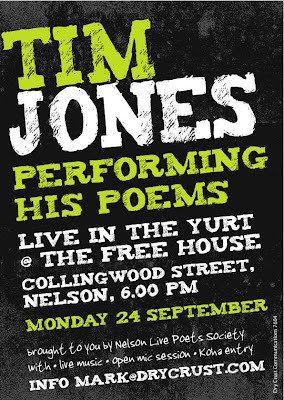
Media Release –
6 September 2012
Manhood
and science fiction - out of this world poetry at the Free House
Science
fiction and manhood are set to do a merry dance at Nelson’s Free
House this month as poems from the collection Men
Briefly Explained
and the science fiction poetry anthology Voyagers,
get
an airing at Nelson Live Poets.
Tim Jones, poet and science
fiction writer from Wellington, is the featured guest at the Nelson
Live Poet’s Society’s September gathering.
Jones
will be performing poems from Voyagers:
Science Fiction Poetry from New Zealand
(Interactive Press, 2009, co-edited with Mark Pirie), and
will also treat the audience to samplings from his latest collection
of poems, Men
Briefly Explained (2011).
Men
Briefly Explained, his third book of poems, explores
all aspects of contemporary manhood, the humorous and not so
humorous, and lifts the covers on where men are in relation to women
and to society in general!
The mix of science fiction and
manhood promises an entertaining night in The Yurt at the Free House
as Live Poets continues to encourage and promote a wide range of both
local and national poetic talent.
Among his other
recent books are the fantasy novel Anarya’s
Secret
(RedBrick, 2007) and a short story collection Transported
(Vintage, 2008).
Voyagers
won the “Best Collected Work” category in the 2010 Sir Julius
Vogel Awards and was listed as one of the Listener's
100 Best Books of 2009. Jones was also awarded the NZSA Janet
Frame Memorial Award for Literature in 2010.
As well as performing his poems at
Nelson Live Poets, Tim Jones will be attending the Golden Bay Lit
awards as this year’s guest judge.
Local poets also get the
opportunity to perform their work during the regular and legendary
open mic sessions. These sessions give Live Poets its beating heart
as first-timers and established performers stand together to deliver
words of wisdom and wonder!
Open mic performers, who have
slots before and after the night’s guest, can register on the
night. Jim Doak will open the evening with song and guitar.
ENDS
Live
Poets Society
Featuring
Tim
Jones
In
the Yurt @The Free House
Collingwood
Street, Nelson.
on
Monday evening, 24 September , 2012
Doors
open: 6.00 pm
Music
from 6.30 pm.
Koha
entry.
ENDS
Further
information:
Carol
Ercolano - 03-545
0162
Mark
Raffills – 03 544 4975
Nelson
Live Poets Society
You can buy books by Tim Jones online! Voyagers: SF Poetry from NZ from Amazon.Transported (short story collection) from Fishpond or New Zealand Books Abroad.

Published on September 17, 2012 03:36
September 12, 2012
Vote Takahe Campaign Denies Public Money Used For Campaign Video
The Vote Takahe campaign today denied that public money had been used to promote their Bird of the Year 2012 election campaign. Rival birds claimed yesterday that the following promotional video about Takahe had been made by a TV channel funded by public money:
Members of the Takahe campaign refused to come into the studio to answer this allegation, but the campaign did provide the following video response:
Experts in Takahe language have interpreted this statement to mean "Vote Takahe as Bird of the Year 2012!", and you can do just that at the Bird of the Year site.
Some actual facts about takahe
The takahē is an endangered flightless bird indigenous to New Zealand.
Takahē once lived throughout the North and South Islands and were thought to be extinct until rediscovered by Geoffrey Orbell near Lake Te Anau in the Murchison Mountains, South Island in 1948.
Today’s population is around 260 birds at various sites including the Murchison Mountains in Fiordland as well as the pest-free islands Tiritiri Matangi, Kapiti, Mana and Maud and mainland sanctuary of Maungatautiri, near Cambridge.
Some takahē have lived for over 20 years in captivity, but in the wild few would live to more than 15 years of age.
Since the 1980’s, DOC has been involved in managing takahē nests to boost the birds' recovery. Artificial incubation of eggs and rearing of chicks is carried out at the Burwood Bush rearing unit, Te Anau, where five pairs are held to form a small breeding group.
(Taken from http://www.scoop.co.nz/stories/AK1208/S00260/tiritiri-matangi-island-loses-iconic-bird.htm and posted in memory of Greg the Takahe, who died in August.)
You can read more about the Vote Takahe campaign here and join the campaign on Facebook.You can buy books by Tim Jones online! Voyagers: SF Poetry from NZ from Amazon.Transported (short story collection) from Fishpond or New Zealand Books Abroad.

Members of the Takahe campaign refused to come into the studio to answer this allegation, but the campaign did provide the following video response:
Experts in Takahe language have interpreted this statement to mean "Vote Takahe as Bird of the Year 2012!", and you can do just that at the Bird of the Year site.
Some actual facts about takahe
The takahē is an endangered flightless bird indigenous to New Zealand.
Takahē once lived throughout the North and South Islands and were thought to be extinct until rediscovered by Geoffrey Orbell near Lake Te Anau in the Murchison Mountains, South Island in 1948.
Today’s population is around 260 birds at various sites including the Murchison Mountains in Fiordland as well as the pest-free islands Tiritiri Matangi, Kapiti, Mana and Maud and mainland sanctuary of Maungatautiri, near Cambridge.
Some takahē have lived for over 20 years in captivity, but in the wild few would live to more than 15 years of age.
Since the 1980’s, DOC has been involved in managing takahē nests to boost the birds' recovery. Artificial incubation of eggs and rearing of chicks is carried out at the Burwood Bush rearing unit, Te Anau, where five pairs are held to form a small breeding group.
(Taken from http://www.scoop.co.nz/stories/AK1208/S00260/tiritiri-matangi-island-loses-iconic-bird.htm and posted in memory of Greg the Takahe, who died in August.)
You can read more about the Vote Takahe campaign here and join the campaign on Facebook.You can buy books by Tim Jones online! Voyagers: SF Poetry from NZ from Amazon.Transported (short story collection) from Fishpond or New Zealand Books Abroad.

Published on September 12, 2012 00:19
September 10, 2012
Tuesday Poem: Prove You Are Not A Robot, by P. S. Cottier
Prove that you are not a robot.
Affirm android is what you're not.
Prick a digit, we'll watch the blood flow
(though nanovamps may swim, and grow).
Indicate a lack of chips embedded -
that you are only fleshy headed,
with just the right amount of brain
to reason, love and feel all pain.
Now fill in the code that we select -
words unknown to mortal intellect.
Quickly, for we're losing time -
our batteries run down at nine.
Credit Note: This is an original poem by P. S. Cottier and is published here by permission of the author - and if you have not already done so, you should check out her blog.
Tim Says: The first time I saw the command to "Prove that you are not a robot", I suffered a prolonged period of existential dread. Might I, in fact, be a robot? Might there be telltale signs? How could I prove I wasn't?
P. S. Cottier did something more useful. She wrote a poem - and here it is. I really like it.
The Tuesday Poem: One does not simply walk into The Tuesday Poem. One clicks.You can buy books by Tim Jones online! Voyagers: SF Poetry from NZ from Amazon.Transported (short story collection) from Fishpond or New Zealand Books Abroad.

Published on September 10, 2012 05:41
September 9, 2012
Voting Now Open: Vote Takahe for Bird of the Year 2012
It's on! Forest and Bird's 2012 Bird of the Year competition is now open - and this means that you can Vote Takahe right now, and encourage all your friends (and enemies) to do likewise!
Here is where you can vote: http://www.birdoftheyear.org.nz/
While most of you will understand that the takahe is just naturally cooler, sexier, and more electable than any other bird, there might be a few people who are wondering what's in it for them. Read Friday's announcement of the takahe campaign below and you'll have your answer - and if you're still a swinging voter, check back later in the week for a Vote Takahe FAQ that will answer questions you didn't even know you wanted asked.
Friday's announcement
What: Every year, the excellent conservation organisation Forest and Bird holds its Bird of the Year competition. The 2012 competition opens on Monday 10 September. And this year, I am the campaign manager for the rightful winner of that competition, the takahe.
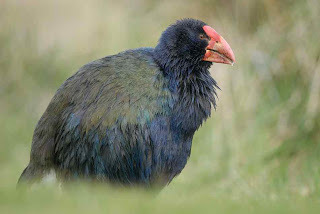
Photo: Steve Attwood
Who: Yes, the takahe. There's one, right there, comin' at ya. It's the pukeko's bigger, cooler, rarer cousin. And the news that the pukeko won the 2011 competition? The takahe isn't taking that well at all.
Why: There are a lot of reasons why you should vote for the takahe, and I'll be telling you all about them over the next three weeks. Here are three to start with.
1) The takahe is a survivor. It was thought to be extinct for more than half a century - but it wasn't, and one determined naturalist, Dr Geoffrey Orbell, kept looking for it until he found it in the Murchison Mountains of Fiordland. When he clambered up the mountains and found them, the takahe just kept on going about their business. They didn't throw a big party or anything.
2) The takahe is beautiful. Just look at those gorgeous feathers!
3) If you don't Vote Takahe, it might peck you on the knee. True story: A takahe once pecked a photographer friend of mine on the knee as he was photographing it - this was in the days before the general public had access to takahe, as they do today, e.g. at Zealandia and on Kapiti Island. He kept taking photos. The takahe kept pecking his knee. And I lived to tell you the tale.
When: The competition opens on Monday 10 September and runs for three weeks.
How: You'll be able to vote for the takahe online from Monday onwards. Vote early. Vote often (am I allowed to say that?). Tell your friends to vote, and use social media to pimp out these important hashtags: #votetakahe and #birdoftheyear. I'll be tweeting like a bird that tweets - takahe don't tweet, because they're far too cool.
There'll be plenty more to come during the campaign, including a set of Frequently Asked Questions about the Takahe that I'm just about to make up. There will be more photos, some actual facts, and a comparison of the takahe with the honey badger. Keep checking this blog, keep voting, and keep watching the skies!*
*But not for takahe - they're flightless.
You can buy books by Tim Jones online! Voyagers: SF Poetry from NZ from Amazon.Transported (short story collection) from Fishpond or New Zealand Books Abroad.

Published on September 09, 2012 14:29
September 6, 2012
Vote Takahe for Bird of the Year 2012
What: Every year, the excellent conservation organisation Forest & Bird holds its Bird of the Year competition. The 2012 competition opens on Monday 10 September. And this year, I am the campaign manager for the rightful winner of that competition, the takahe.

Photo: Steve Attwood
Who: Yes, the takahe. There's one, right there, comin' at ya. It's the pukeko's bigger, cooler, rarer cousin. And the news that the pukeko won the 2011 competition? The takahe isn't taking that well at all.
Why: There are a lot of reasons why you should vote for the takahe, and I'll be telling you all about them over the next three weeks. Here are three to start with.
1) The takahe is a survivor. It was thought to be extinct for more than half a century - but it wasn't, and one determined naturalist, Dr Geoffrey Orbell, kept looking for it until he found it in the Murchison Mountains of Fiordland. When he clambered up the mountains and found them, the takahe just kept on going about their business. They didn't throw a big party or anything.
2) The takahe is beautiful. Just look at those gorgeous feathers!
3) If you don't Vote Takahe, it might peck you on the knee. True story: A takahe once pecked a photographer friend of mine on the knee as he was photographing it - this was in the days before the general public had access to takahe, as they do today, e.g. at Zealandia and on Kapiti Island. He kept taking photos. The takahe kept pecking his knee. And I lived to tell you the tale.
When: The competition opens on Monday 10 September and runs for three weeks.
How: You'll be able to vote for the takahe online from Monday onwards. Vote early. Vote often (am I allowed to say that?). Tell your friends to vote, and use social media to pimp out these important hashtags: #votetakahe and #birdoftheyear. I'll be tweeting like a bird that tweets - takahe don't tweet, because they're far too cool.
There'll be plenty more to come during the campaign, including a set of Frequently Asked Questions about the Takahe that I'm just about to make up. There will be more photos, some actual facts, and a comparison of the takahe with the honey badger. Keep checking this blog, keep voting, and keep watching the skies!*
*But not for takahe - they're flightless.You can buy books by Tim Jones online! Voyagers: SF Poetry from NZ from Amazon.Transported (short story collection) from Fishpond or New Zealand Books Abroad.

Published on September 06, 2012 21:31
September 3, 2012
Tuesday Poem: And yet it moves, by Helen Heath
And yet it moves Galileo Galilei (1564-1642)
you say of the earth
- not the sun around us.
You cannot close your eyes
to the view at the end
of the eyeglass. Faith
is not a veil. Eyes drawn
to the stars, the suns, again
and again for years until
they burn through your lenses
twin black holes, one for each eye.
The dark slowly spreads.
The inquisition judges heresy,
commands a recant, wants blind
allegiance from a man in the dark
so you recant, muttering
and yet it moves.
Credit note: "And yet it moves" was published in Helen Heath's collection Graft (VUP, 2012) and is reproduced here by permission of the author.
Tim says: I've just finished reading Graft, and while I enjoyed the whole collection, the highlight for me was a number of wonderful poems about science, scientists and the history of science - other include the prizewinning Making tea in the universe and Night's Magic. This poem about Galileo Galilei elegantly captures the great dilemma of his life.
The Tuesday Poem: You can read the hub Tuesday poem on the Tuesday Poem blog, and all the other Tuesday Poems are linked from the sidebar to the left.You can buy books by Tim Jones online! Voyagers: SF Poetry from NZ from Amazon.Transported (short story collection) from Fishpond or New Zealand Books Abroad.

Published on September 03, 2012 14:48
August 29, 2012
An Interview With Sugu Pillay

Sugu Pillay is a poet and fiction writer who was born in Malaysia and now lives in Wellington. Her writing has appeared in journals, and online, and her first collection of short stories, The Chandrasekhar Limit and Other Stories, was published in 2002.
Sugu's first poetry collection, Flaubert's Drum, has just been published by IP. At the time of writing, Sugu and fellow poet Karen Zelas, with publisher and poet Dr David Reiter, are currently touring their new collections around New Zealand - look out for them at a poetry venue near you! I am looking forward to attending their Wellington launch event on Monday 3 September.
I ran the title poem of Sugu's collection as my Tuesday Poem this week, and Sugu was kind enough to answer the following five questions:
1. What is the
significance of the title, Flaubert’s
Drum?
As explained in the Notes at the back of the collection, it
refers to Flaubert’s comment: “Human language is like a cracked kettle on which
we beat our tunes for bears to dance to when all the time we long to move the
stars to pity”. Writers struggle with articulation, swinging on this pendulum
from the drum of the cracked kettle to the desired Music of the Spheres! The title poem on page 37 exemplifies this
problem of articulation.
2. How is Flaubert’s Drum organised? Does the
collection have an overarching theme, or will the readers recognise a number of
themes within it?
Flaubert’s Drum
was submitted for IP’s 2012 Best Poetry competition as a collection of mostly
published poems written over a long period. Grouping the poems under suitable
headings is the only “organising” they have undergone. However, I could say the
theme of Loss and the problem of its articulation, runs through many of the
poems. Loss can be death of a loved one, the loss of love, loss of meaning, the
loss of one’s place in the world, a dislocation.
3. I know from
reading some of the poems in literary magasines that your experience as an
immigrant to this country has featured in your poetry. Is this also the case in
Flaubert’s Drum?
The first section under the heading ‘From Mission Bay to St
Heliers’, has nine poems which express “the poetics of migrancy” in the voice
of an invented persona, an immigrant artist. Although each poem has its own
raison d’ étre,
together the poems explore “the narrative of assimilation”, an on-going
negotiation with oneself and everything encountered in the new land. There is
another section, ‘Who Said What’ which unlike ‘Mission Bay to St Heliers’ is a
personal response to experiences in “this other Eden”. In a sense, all immigrants are on a pilgrim's progress from initial euphoria, depression and adjustment to acceptance of their chosen "other Eden".
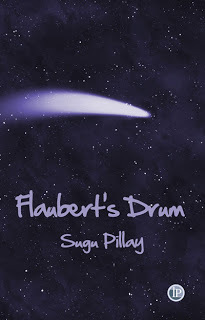
4. Who are some of
your favourite poets or poets who have influenced your own writing?
Favourites change with the times. I had a very British
colonial education. I fell in love with poetry in the Fourth Form when I
encountered Keats, Wordsworth, Coleridge, Shelly, Byron. At the University of Malaya, we read the then pantheon of
English poets from Chaucer to T.S. Eliot in the First Year, with in-depth study
in the Second & Third Years. My favourites were the Metaphysical poets,
especially Donne and Marvell. Their
inventiveness of metaphor and “conceits” still delight and inspire.
Stylistically I can’t claim a particular influence. I think every poet you read stays
somewhere in your subconscious, surfacing unexpectedly in the midst of your
writing, like Donne’s “Busy old fool, unruly Sun” (and Cat Steven’s “Morning is
breaking”) ringing in my head as I write “here comes the sun of pop songs/
& metaphysical poets/breaking the morning /with its glare & demands/for
purposeful activity”.
It was much later, that I read American, Canadian, Australian and New Zealand
poets. When I lived in Auckland for about two years, I was influenced by poets like Michele Leggott, Wystan Curnow and those who were regular contributors to A brief description of the whole world (now abbreviated to brief thankfully!). You would have noticed in my poems the use of borrowed lines in italics. I copied this from Michele Leggott. This was the period when I read voraciously on Post-Modern
writing. I absolutely loved the intertextuality dense with references and
cross-references. There’s an electricity in subtexts! However, I learnt to
write in a variety of ways.
It seems to me while you use poetic devices in many
ways to land your poems, you can decide whether you want to parachute to safety
and make your poems very accessible to your readers, or you can parachute for
sheer fun, use word play and verbal gymnastics creating poems which are fun to
unpack. Or you can parachute to a secret destination, leaving no clear guide
for the reader, making the poem a challenging “writerly” text inviting the
reader’s active participation in the creative process. I hope I have written
all three types in Flaubert’s Drum.
5. Finally, and if you don’t mind me asking, what are you working on at present?
I have three plays and a novel in the burner but they’ve been there for quite some time now! For poetry, I have a rather ambitious project, Voices. The inspiration comes from the Upanishads which are ancient Sanskrit texts going back to 800 BC. They are abstract philosophical speculations about Creation, the nature of the Self and Reality. About 14 Upanishads are said to exist but I’ve only read 10 of them in English translation. Here’s a tantalising bit from the Isa Upanishad : “They have put a golden stopper in the neck of the bottle. Pull it, Lord! Let out reality. I am full of longing”.
Book availability details
Flaubert's Drum is available from IP, from a range of online sources including iTunes and Amazon.com, and through bookshops. The ISBN is ISBN 9781921869945.You can buy books by Tim Jones online! Voyagers: SF Poetry from NZ from Amazon.Transported (short story collection) from Fishpond or New Zealand Books Abroad.

Published on August 29, 2012 18:20
August 27, 2012
Tuesday Poem: Flaubert's Drum, by Sugu Pillay
that
harlequin tear again
its
fall threatened in Keats’ time
her
soapy slippery anguished palms
cup
for the reflecting bell-jar
each
drop
the
world’s grammar
the
Rosetta stone
plows
wide furrows
meets
with resistance
may or
may not connect
never
certain that it should
each
known thing easily
becomes
unknown
like
that cracked kettle
of
Flaubert’s
Credit note: This is the title poem of Sugu Pillay's debut poetry collection Flaubert's Drum, which has just been published by IP, who also published my collection Men Briefly Explained.
Tim says: Sugu and fellow poet Karen Zelas, with publisher and poet Dr David Reiter, are currently touring their new collections around New Zealand - look out for them at a poetry venue near you! I am looking forward to attending their Wellington launch event on Monday 3 September.
Watch out for my interview with Sugu Pillay, which should appear here on Thursday.
The Tuesday Poem: You can find links to this and all the other Tuesday Poems on the left of the Tuesday Poem blog, where you will also find the hub poem for the week.You can buy books by Tim Jones online! Voyagers: SF Poetry from NZ from Amazon.Transported (short story collection) from Fishpond or New Zealand Books Abroad.

Published on August 27, 2012 14:07
August 23, 2012
Mansfield with Monsters: An Interview With Matt And Debbie Cowens

Matt and Debbie Cowens are both high school teachers who
live and work on the Kapiti Coast. They’ve each had a number of short stories
published online and in anthologies. Mansfield with Monsters is their first
collaborative collection of short stories – collaborating with each other and
with New Zealand’s most iconic writer of short fiction, Katherine Mansfield.
Tim adds: Mansfield with Monsters is the second book published by Steam Press, a new New Zealand science fiction publisher which has made quite an impact since it was set up.
Why Mansfield, and why with monsters?
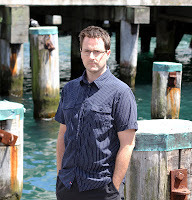
We’re both fans of the science fiction and horror genres, and we’re very familiar with Mansfield’s work as we’ve taught her stories in high school. The opportunity to build a bridge between the two was too tempting to pass up. It created a lot of pressure to do justice to both Mansfield, as New Zealand’s most iconic writer, and to the speculative genre we love, but it was enormously satisfying to weave the two together.
Did you look at other works in the mash-up genre, like Pride
and Prejudice and Zombies or Sense and Sensibility and Sea Monsters , when planning Mansfield with Monsters ?
Debbie had read Pride and Prejudice and Zombies, which blazed a trail in the concept of reworking classic fiction which is in the public domain, but we wanted to take Mansfield
with Monsters in a slightly different
direction. It was important to us to have the supernatural or otherworldly
elements work with the source material on a thematic as well as a literal
level. Of course we also had the luxury of working with multiple stories,
exploring different kinds of creatures and mythologies, and how they could fit
into the lives of Katherine Mansfield’s characters, which kept the project
fresh and makes it a little different to other mashups.
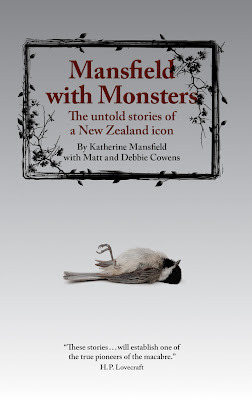
Katherine Mansfield’s writing is not usually plot-heavy. Did that cause a problem for you when you came to rework these stories, and if so, what strategies did you use to get around it?
Mansfield’s stories are quite varied, so we tackled each one
a little differently. A story like The Doll’s House follows a clear sequence of events to reveal the
injustice of prejudice and the class system. We took that concept and pushed it
to a darker place, filling in little details along the way to twist the story
into a tale of witchcraft, murder, possession and insanity – borne out of
prejudice and the injustice of the class system. Other stories were more
stream-of-consciousness and we had to be more bold in our reshaping. It was a
delight to sit down with each story and deconstruct it, probe it for areas
where the supernatural could worm its way in, or turn it upside down and give
it a good shaking to see what the bones of the story were and whether we could
arrange those bones into a different but coherent shape, like literary
archaeologists building their own ‘Tyrannosaurus Mansfield’.
On the other hand, of course, there is a Gothic – and New
Zealand Gothic – flavour to a number of Mansfield’s stories. You start the
collection with your version of “The Woman at the Store” – was it that story’s
pre-existing atmosphere of menace that made you decide to start the collection
with it?
Our wonderful editor Stephen Minchin decided the final order
of the stories. The Woman at the Store
is a story which already bordered on horror, and cast New Zealand in an
interesting Wild West, frontier light. Twisting it to include a Pet Cemetery vibe maintained the dark sense of menace of the
previously published version whilst referencing a classic of modern horror. It
signals to the reader that the collection is less tongue-in-cheek than
something like Pride and Prejudice and Zombies. We asked Stephen why it was first up in the
anthology and his sagely answer was that the stories are chronological in terms
of first publication.
It may seem odd to ask about a story you haven’t included,
but when I opened the book I was looking forward to reading your version of “At
the Bay” – yet I see that you haven’t included it. Did you know from an early
stage what stories you would include, or did you experiment with more stories
than made it to the published collection?
We read a wide range of Mansfield’s stories and explored the
copyright laws of various countries. Mansfield’s death in 1923 placed her early
works in the public domain in all the countries we wanted to reach, but some of
her posthumously published stories are still owned by American publishers. We
looked for stories which sparked our imaginations, stories which gave us
opportunities to write a range of speculative adaptations. We were guided by
intuition, by inspiration, and by legal constraints. At the Bay was tempting as we both love it, but it was
structurally difficult and the idea of how to make to work without excising
enormous tracts of text never quite clicked into place.
Has working with a number of her stories “from the inside”
changed your opinion of Katherine Mansfield and her writing?
Mansfield’s place in New Zealand’s literary pantheon is well
deserved – this process served to reinforce that view for us. Her writing is
diverse and crafted and bleak and funny and relevant and historical – it’s
incredibly powerful and moving. We each became more intimately acquainted with
Mansfield’s stories and in working with her learned a great deal about the
power of words, of inflection and suggestion. It was a delight and lead us to
read Mansfield more widely – something we hope it will do for others too.
When I first heard of this project, I thought to myself that
it would be very interesting to see how the literary community reacted to it:
would there be guardians of the temple of New Zealand literature who would
disapprove of the project? My impression is that reaction, overall has been
very positive. Is that your experience too?
We’ve been very happy with the reception the novel has
received so far. It was a risky proposition but people have been very open to
the idea, from the Katherine Mansfield society to academics to devoted
fans. For younger readers
Mansfield is definitely a historical figure, someone from a distant time whose
life and work can have a degree of remoteness. It was part of our aim to reach
out to a more modern audience with these stories. It’s a collection written out
of love for Mansfield’s work and for the horror and science fiction elements we
blended with them. It’s a tribute to a great writer, and so far it has been
received as such.
You are both school teachers. Do you plan to, or could you
see yourselves, using Mansfield with Monsters as a teaching tool?
Definitely. We know of a couple of schools where the stories
have already been used and the feedback from students and teachers has been
really positive. We’re working on some activities to help teachers use Mansfield
with Monsters and other literary mash-up
works as a point of comparison with their source material.
If you don’t mind me asking, what other literary projects do
you have on the go?
We’re both working on our own individual novels at present.
Debbie is working on a young adult novel set in a Steampunk Victorian academy
for aspiring villains, while Matt is reworking a manuscript dealing with
ghosts, secret societies and arcane science in nineteenth century New Zealand.
The collaborative process was wonderful and went very smoothly, so we may well
return to a joint writing project in the future. For now we are savouring the
success of Mansfield with Monsters.
How to buy Mansfield with Monsters
Mansfield with Monsters
is currently available online at www.steampress.co.nz
and www.amazon.com as well as in Unity
Books and Arty Bee’s in Wellington, and Paper Plus, Whitcoulls and independent
bookstores throughout New Zealand.
You can buy books by Tim Jones online! Voyagers: SF Poetry from NZ from Amazon.Transported (short story collection) from Fishpond or New Zealand Books Abroad.

Published on August 23, 2012 18:08
August 13, 2012
Tuesday Poem: The Wind Blew Back Biff Byford's Hair
We stand in the face of the wind, of the
wind machine
Our stylists ready with product and comb
We take up our stance and seize our guitars
In the face of the wind, of the wind
machine.
We sing in the face of the war, of the war
machine
Our stylists ready with product and comb
We watch the director and follow his cues
In the face of the war, of the war machine.
We laugh in the face of death, of the death
machine
Our stylists ready with product and comb
We tease out highlights and re-shoot some
takes
In the face of death, of the death machine.
We sneer in the face of hate, of the hate
machine
Our stylists ready with product and comb
We shout out to fans who've stayed staunch
and true
In the fact of hate, of the hate machine.
In the face of hate, in the face of death
In the face of the war, in the face of the
wind
We take up our stance and seize our guitars
Our stylists ready with product and comb.
Credit note: This is one of the poems I cut from the final manuscript of Men Briefly Explained. It is published here for the first time.
Tim says: You will scarcely need reminding that Peter Rodney "Biff" Byford was the magnificently-maned lead singer of Saxon, one of the bands that came to prominence in the New Wave Of British Heavy Metal, or NWOBHM as one should properly call it (Nu-wobbem).
Here's Biff's barnet getting a good workout in an otherwise rather dubious hair-metal cover of Christopher Cross's yacht-rock hit "Ride Like The Wind"from 1988: http://www.youtube.com/watch?v=E0OFr3-JPSE
After Billy Collins invented a parody of the villanelle called the Paradelle, I felt I had to go one better (or worse). I call the form I have invented for this poem the "Paradiddle", and hope that more poets will take up the challenge to write in this form, especially when writing poems about the lesser bands of the NWOBHM era.
My poetic tribute to the St Valentine's Day Massacre EP by the combined forces of Girlschool and Motörhead, should it proceed, is almost certain to be in the form of a paradiddle. I plan to call it "Please Don't Touch": http://www.youtube.com/watch?v=D5dAyPoYax4 (R.I.P. Kelly Johnson, sadly missed).
The Tuesday Poem: can be found in all its multifarious splendour on, and in the sidebar at the left of, the Tuesday Poem blog.
You can buy books by Tim Jones online! Voyagers: SF Poetry from NZ from Amazon.Transported (short story collection) from Fishpond or New Zealand Books Abroad.

Published on August 13, 2012 05:27



